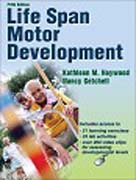
Life Span Motor Development, Fifth Edition", is the only introductory textbook to use the model of constraints (or dynamical systems) approach in discussing reasons for changes in movement throughout the life span. This fully updatededition encourages students to observe and examine how the interactions of the individual, environment, and task affect changes in a person's movements. The principles of motor development are presented in a clear and accessible manner so that even readers with minimal movement science background will comprehend the material. "Life Span Motor Development, Fifth Edition", will give readers the foundation for continued study and real-world practice. The text beginsby introducing students to the basics: motor development, the model of constraints, and the theoretical perspectives relevant in motor development research. After laying the groundwork, the text describes the physical growth and maturation process from infancy to old age, including development and aging effects of specific body systems. Age-related changes in sensation and perception inthe visual, kinesthetic, and auditory systems are also explained. The fifth edition contains several content changes to make the text more user friendly than ever. The inclusion of a chapter discussing the principles of biomechanics presents students with foundational knowledge to ground their understanding ofthe sequential changes in motor skills development. The text shows how the four components of physical fitness-cardiorespiratory endurance, strength, flexibility, and body composition-interact to affect a person's movements over the life span. It also describes how relevant social, cultural, psychosocial, and cognitive influences can affect a person's movements. "Life Span Motor Development, Fifth Edition", not only provides students with the observational skillsnecessary for assessing motor development, but it also expertly ties the information to real life. This edition emphasizes the application of motor development concepts to the real world by beginning each chapter with an example of acommon experience and then revisiting that experience at the end of the chapter, allowing readers to apply the material to the example. Application questions throughout the chapters challenge readers to consider how parents or professionals might use the material discussed. To further solidify their understanding, students are provided with a key code allowing them to access an interactive online student resource containing 33 lab activities that can be printed, 21 learning exercises, and more than 200 video clips with footage focusing on infants, toddlers, young children, adolescents, and adults performing fundamental motor skills-subjects often difficult to study because of permissions and policies, particularly for minors. For each video clip, students can pause, replay, or change the rate of speed, giving them flexibility to analyze and thencategorize each subject into the appropriate developmental level. Selected video clips are also used with many of the lab activities to provide visual examples of developmental levels. For professors, the text includes a full array of ancillaries, including an updated instructor guide, test package, presentation package, and a newly added image bank. "Life Span Motor Development, Fifth Edition", will also assist students in meeting AAHPERD's Motor Development Academy standards. The text presents essential competencies identified by AAHPERDand provides guidelines for constructing developmentally appropriate activities and designing learning experiences to meet grade-level expectations in preparation for the Praxis exam for physical education. Chapters are organized forstudent learning with opening scenarios providing real-life experiences or applications involving motor development in daily living. There are also learning objectives emphasize the chapter's key concepts and a running glossary provides easy access to definitions of important terms. Throughout the book, key points indicate the theme of a discussion amidst chapter details and highlight boxes provide additional insights into motor development assessment. Through application questions, students' problem-solving skills will be challenged. "Life Span Motor Development, Fifth Edition", encompasses the most current research in motor development. It is enhanced with practical online resources for instructors and students, making the fundamental concepts of motor development come alive. By starting with basic ideas in motor development and progressing tolarger developmental concepts, this fifth edition will prove to be a beneficial resource for those in the field. The text gives readers a solid foundation not only for beginning their studies in motor development but also for applying the concepts to real-world situations. ÍNDICE: Chapter 1. Fundamental Concepts; Chapter 2. Theoretical Perspectives in Motor Development; Chapter 3. Principles of Motion and Stability; Chapter 4. Physical Growth, Maturation, and Aging; Chapter 5. Development and Aging of Body Systems; Chapter 6. Early Motor Development; Chapter 7. Development ofHuman Locomotion; Chapter 8. Development of Ballistic Skills; Chapter 9. Development of Manipulative Skills; Chapter 10. Sensory-Perceptual Development; Chapter 11. Perception and Action in Development; Chapter 12. Social and Cultural Constraints in Motor Development; Chapter 13. Psychosocial Constraints in Motor Development; Chapter 14. Knowledge As Functional Constraint in Motor Development; Chapter 15. Development of Cardiorespiratory; Chapter 16. Development of Strength and Flexibility; Chapter 17. Development of Body Composition; Chapter 18. Conclusion: Interactions Among Constraints
- ISBN: 978-0-7360-7552-7
- Editorial: Human Kinetics Publishers
- Encuadernacion: Cartoné
- Páginas: 408
- Fecha Publicación: 01/01/2009
- Nº Volúmenes: 1
- Idioma: Inglés
